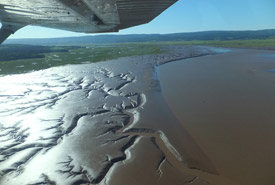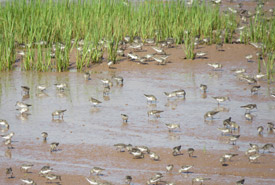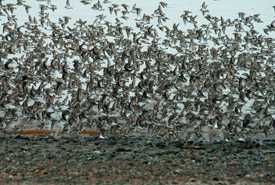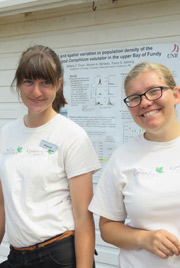Mudflats of New Brunswick

Flying over the vast mudflats at Johnson’s Mills, NB (Photo by NCC)
Brown. Flat. Smelly? A mudflat may not seem exciting at first glance. Even to those who grew up around the Bay of Fundy and are familiar with mudflats stretching as far as the eye can see, they may at first appear lifeless. But this couldn’t be further from the truth!
We are from Ontario and Nova Scotia, and neither of us truly understood the life that the mudflats support until we set out to collect handful after handful of mud to bring back to the lab for research at the Mudflat Ecology Lab of Mount Allison University where we worked as field/research assistants. And this past summer, we had the opportunity to apply our knowledge as interpreters at Nature Conservancy of Canada’s (NCC's) Johnson’s Mills Interpretive Centre!
The mud in the Bay of Fundy is soupy and from the first step; we knew we would be muddy. We also knew we were not alone. Our first clue were noises that sounded a lot like rice crispies cereal. The snap, crackle and pop noises that filled the air were actually from mud shrimp, crawling along the surface of the mud!

Semipalmated sandpipers feeding on the mudflat. (Photo by NCC)
Now, these aren’t the kind of shrimp you might find in your pad Thai. The largest are only the size of a grain of rice, and the mudflats are teeming with billions of these little creatures. They are a hugely important part of the community because all of their burrows hold the mudflat together, so that as the tide rushes in and out, the mud stays put. It should be no surprise that they would crawl all over our feet while we romped around in the mud. To those who go mud sliding — you’re probably covered with hundreds after your adventures!
The mud shrimp are only part of the mudflat’s story. We cannot count the number of times that we raised our foot while walking out on the mud to see a huge worm pull back into its burrow. Under the microscope, some of these worms look like they could play a starring role in a horror movie with jaws and four eyes!
Lots of other tiny creatures within the mud are almost too small to see with the naked eye, but are important parts of the food chain. All food chains in this ecosystem depend on the sticky mud juice that is spread over the surface of each mudflat, which contains microscopic plants that convert the sun’s energy into energy that other critters use to move around the mud.
The mudflat’s surface is home to many other animals that use the vast landscape as a delicious buffet! When the tide is high and water floods over the mudflats, flatfish, eels, crabs, sea ducks and more will all come to feast on the critters in the mud.
The most famous visitor to the mud flats of the Bay of Fundy — the semipalmated sandpiper —arrives for a feeding frenzy during July and August of every year. These small shorebirds need to stop on the mudflats to gain enough weight to make a three-day, non-stop flight down to South America! The mudflats are such large, food-filled sites that they are essentially the only fueling stop for more than half a million sandpipers on their way from the Arctic to South America — that’s most of the world’s population of these little birds!

Semipalmated sandpiper (Photo by NCC)
Why wouldn’t the sandpipers stop somewhere else that may be a bit prettier or less muddy? Their feet are specially adapted to be able to walk through the mud without sinking, and their bill allows them to peck and reach all the mud shrimp and worms that hide below the surface.
Having taken a number of flights in a cramped, little airplane to count these birds, we also know that from above, the mudflats are stunning pieces of art! Creeks cut through the smooth mud, creating a patchwork of places for the sandpipers to munch on some delicious little critters. Who wouldn’t want to stop here?
We have spent this past summer as interpreters, watching the tide move in and out over the vast mudflats at Johnson’s Mills, one of NCC’s most beautiful sites. Even after months of watching these mudflats, we are still in awe of how much they change if you just have a little patience. Over the summer, the mud smoothed out the craters created by huge ice chunks in the winter, the snails have slowly covered the mud as far as the eye can see and clumps of grass have grown while basking in the summer’s sun.
At first glance, the mudflats of the Bay of Fundy may seem to be a boring, desolate place. But spend a little time around them and we are sure that, just as we have, you will learn to love the life they support and even the mud itself.


